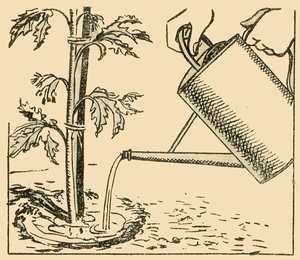THINNING
This needs to be done now practically every week. Beet, carrots, parsnips, lettuce and spinach have all to be thinned as they become large enough. Thinning was dealt with in the May “Guide” and all that it is necessary to add now is that it is a good time to apply a little fertilizer after the plants have been thinned and are beginning to grow strongly. A dressing of ½ oz. of sulphate of ammonia can be hoed in per yard of row.
TOMATOES


 The May “Guide” dealt with the planting of tomatoes. To get the best results keep each plant to the main stem, pinching out the side-shoots that come in the corners formed by the leaf stalks and the main stem. Keep the plants well watered and feed them regularly with a good complete fertilizer.
The May “Guide” dealt with the planting of tomatoes. To get the best results keep each plant to the main stem, pinching out the side-shoots that come in the corners formed by the leaf stalks and the main stem. Keep the plants well watered and feed them regularly with a good complete fertilizer.
There are a number of proprietary brands of tomato fertilizer that should be used according to the suppliers’ instructions. Or you can use “National Growmore.” A good working rule is to apply a teaspoonful per plant as each truss of fruit sets.
When watering, remember that it is useless just to damp the soil surface, for this merely encourages surface rooting. You must water well, giving about half-a-gallon to each plant. Tomato fruits are often split when the plants are given a heavy watering after having been dry. That is because the skin gets hard and inelastic and cannot expand when the fruit swells after a good watering, so it splits or cracks. So don’t let the plants get dry.
“Blight” is the chief disease likely to affect tomatoes in the open. It may attack only the fruit, but the stem and leaves may be affected as well. Intense brown or black blotches are the signs, and infected fruits often fall off the plant. The discoloured areas are edged with a downy white growth. It’s the same blight that attacks potatoes. To control it, spray your plants with a copper spray (see next section).
I suspect that spraying the tomatoes when there are fruits on the vine with a copper spray is not the best thing for your health!


